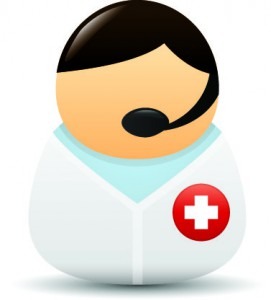Healthcare with Confidence
Epilepsy is a disorder of the central nervous system (neurological disorder), which interferes with the activity of nerve cells in the brain that causes the attack and abnormal behavior of the person, and sometimes loss of consciousness.
Symptoms of epilepsy may be different. Some people just passively watching a few seconds at one point during the attack, while others repeatedly jerking arm or leg.
Treatment may be required, even at moderate cramps, because they can be dangerous, for example, while driving or swimming. Treatment includes usually medication, and occasionally surgery, can eliminate or reduce the frequency and intensity of attacks. In some children epilepsy goes with age.
Because epilepsy is caused by abnormal activity in the brain cells, seizures can affect any process of brain activity.
Epilepsy may be symptoms such as temporary clouding frozen look, uncontrollable jerking of the arms and legs, loss of consciousness or awareness, mental symptoms.
Symptoms vary depending on the type of seizures. In most cases people with experiences the same symptoms from episode to episode.
Seizures are classified as focal or generalized, that is based on the specificity of abnormal brain activity.
Focal seizures are caused by abnormal activity in one area of the brain, they are called focal (partial) seizures. These seizures are divided into two categories:
Simple focal seizures. These seizures do not lead to loss of consciousness. They can change the perception of emotion or change the appearance of things, smells, feelings, taste or sound. They can also cause involuntary twitching body parts, such as hands or feet, and spontaneous sensory symptoms such as tingling, dizziness and flashing in his eyes.
Discognitive focal seizures. These seizures alter consciousness or awareness, and can lead to loss of awareness for a certain period of time. Discognitive focal seizures often lead to stare look and purposeless movements – such as rubbing hands, chewing, swallowing or walking in circles.
Generalized seizures are convulsions which appear as a result of abnormal activity of all brain regions. There are six types of generalized seizures.
Absences. Seizures, which are characterized by stiff look and slight movements of the body. These attacks can lead to a brief loss of consciousness.
Tonic convulsions. Lead to snare muscles. These seizures usually affect the muscles of the back, arms and legs, and can cause you to fall to the ground.
Clonic convulsions. Clonic seizures associated with rhythmic jerking of muscles. These seizures usually affect the neck, face and hands.
Myoclonic jerks. Usually appear as sudden jerks or twitches short arms and legs.
Atonic seizures. Atonic seizures, seizures are also known as drop caused by loss of muscle control.
Tonic-clonic seizures. Also called grand mal seizures are characterized by loss of consciousness, body stiffness and shaking the whole body, and sometimes loss of bladder control or biting their own language.
Epilepsy do not have any specific reason. Approximately half of people with epilepsy it may be caused by various factors:
Genetic influence. Some types of epilepsy observed in the family of the patient. In these cases, it is likely to hereditary factors.
The disease may be caused by some 500 different genes. For most people, the genes are only part of the cause of epilepsy. Certain genes may also make a person more sensitive to environmental conditions that induce convulsions.
Head trauma. Head trauma or due to a car accident other traumatic injury can lead to epilepsy.
Pathological condition of the brain. Brain tumor or stroke may also lead to epilepsy. Stroke is a leading cause of epilepsy in adults older than 35 years.
Infectious diseases. Infectious diseases such as meningitis, viral encephalitis, and AIDS, can lead to epilepsy.
Prenatal injury. While in the womb, babies are sensitive to brain damage that can be caused by factors such as maternal infection, poor nutrition or lack of oxygen. Such brain injury may result in epilepsy or cerebral palsy.
Developmental disorders. Epilepsy can sometimes be associated with developmental disorders such as autism and neurofibromatosis.
The risk of epilepsy may also be increased by factors such as:
Age. The onset of epilepsy is most common in early childhood and after 60 years, but the disease can occur at any age.
Family history. If you have a family history of epilepsy, you may be at increased risk of seizures.
Stroke and other vascular diseases. These diseases can lead to brain damage that can cause epilepsy. To reduce the risk of these factors can be taken a number of measures, including limiting alcohol consumption and smoking, a healthy diet on a regular basis.
Dementia. Dementia can increase the risk of epilepsy in the elderly.
Brain infection. Infections such as meningitis, which causes inflammation in the brain or spinal cord, can increase the risk.
Seizures in childhood. High temperatures during childhood can sometimes be associated with seizures.
Complications
In the fall you can injure your head or break a bone, drowning (in a person with epilepsy is 15 times more likely to drown while swimming, if a seizure occurs in water), car accidents, pregnancy complications (seizures during pregnancy are dangerous for both mother and child, and some anti-epileptic drugs increase the risk of birth defects, so planning pregnancy should be discussed with your doctor), emotional health problems (people with epilepsy often have depression, anxiety, and, in exceptional cases, they lead to suicide, the problem may be a result of difficulties with experience of the state of epilepsy, as well as side effects of treatment), status epilepticus (this condition occurs when a person is in a constant state of seizure activity lasting more than five minutes, or if he has frequent recurrent seizures and it does not come to full consciousness in between them people with status epilepticus have an increased risk of irreversible brain damage and death), a small risk of sudden death in epilepsy (SUDEP), which are the most susceptible people with frequent generalized tonic-clonic seizures, or whose seizures are not controlled by medication. Die a sudden death from 2 to 18 percent of people with epilepsy.
Diagnosis of epilepsy
For the diagnosis of your epilepsy, primarily, the doctor will review your symptoms and medical history. To determine the cause of origin of seizures, can be carried out:
Neurological examination. Behavior, motor skills, mental functions, etc.
Blood tests. The blood sample is analyzed for signs of infection, genetic factors or other factors that may be associated with seizures.
May be involved visual tests cerebral anomalies, such as:
Electroencephalogram (EEG). In this study, the electrodes connected to the head, the brain electrical activity is recorded.
A person with epilepsy, there are common changes in the normal pattern of brain waves, not even in a position to attack. This procedure can be done outside, and during sleep. This recording can help the doctor determine what cramps occur in a patient, or to rule out other factors occurrence of seizures.
Computed tomography (CT). CT uses X-rays to obtain cross-sectional images of the brain. CT can reveal abnormalities in the brain, which can cause seizures, such as
Magnetic resonance imaging (MRI). MRI uses powerful magnets and radio waves to create a detailed picture of your brain. Your doctor may be able to detect damage or abnormalities in the brain (tumors, cysts and bleeding), which can cause seizures.
Functional MRI (fMRI). FMRI measures changes in blood flow that occur when certain parts of the brain work. Doctors may use an MRI before surgery to determine the exact location of important functions such as speech and movement, so that surgeons could avoid injury to these places during the operation.
Positron emission tomography (PET). PET uses a small amount of small doses of radioactive material, which is injected into a vein to help visualize the active regions of the brain and detect anomalies.
Single photon emission computed tomography (SPECT). This type of test is mainly used if MRI and EEG can not pinpoint the abnormal area of the brain.
When SPECT test used a small amount of small doses of radioactive material is injected into a vein to create a detailed 3-D map of the blood flow in the brain activity during seizures. More detailed results can give test called ictal SPECT.
Neuropsychological tests. In these studies, doctors assess thinking skills, memory and speech. The results help experts determine which areas of the brain are affected.
Management of epilepsy
Most people recommended treatment with antiepileptic drugs to reduce the frequency and intensity of seizures.
More than half of children with epilepsy who are symptoms, directed by a physician may stop taking the medication and do not have cramps in the future. Many adults also can discontinue medication after two or more years without seizures.
Finding the right medication and dosage is a complex process and should be carried out only by qualified personnel.
Surgical treatment of epilepsy
Surgery is most often used in cases where the tests show that the attacks occur in a small, well-defined area of the brain, which does not affect vital functions such as speech, language, motor function, vision or hearing. During the operation, an abnormal portion is removed which causes seizures.
If attacks occur in areas of the brain that controls movement, speech, and other functions, the patient is awake during the operation. Doctors monitor the patient and ask him questions during the procedure to monitor brain function.
If attacks occur in the part of the brain that can not be removed, your doctor may recommend another type of operation, when kotoroyj made several cuts in the brain, which are designed to prevent the spread of seizures to other parts of the brain.
After surgery, the dose of drugs taken may be reduced or the medication may be canceled.
To avoid complications, brain surgery should be performed only by specialists with years of experience and highly qualified.
Therapy
Vagus nerve stimulation. In vagus nerve stimulation doctor implants a device called a vagus nerve stimulator under the skin of the breast. This device is similar to a pacemaker. Wires from the stimulator connected to the vagus nerve in the neck. Battery powered device sends bursts of electrical energy through the vagus nerve in mozg.Takoe device usually decreases to 40 percent of convulsions.
Changing diets. Some children with epilepsy reduced the number of attacks in compliance with a strict diet, high in fat and low in carbohydrates. With this diet, the body breaks down fat instead of carbohydrates for energy. A few years later, some children may stop upoltreblenie fat-rich foods, and seizures are not vozbnovlyayutsya.
As a potential treatment of epilepsy, doctors are also studying brain stimulation. Thus, the surgeon implanting the electrode in a certain part of the brain. The electrodes are connected to a generator implanted in the chest or skull. This generator sends electrical pulses to the brain and can reduce seizures.
As a potential treatment of certain types of epilepsy is considered as stereotactic radiosurgery. In this procedure, doctors direct radiation to a specific area of the brain that causes the attack.



